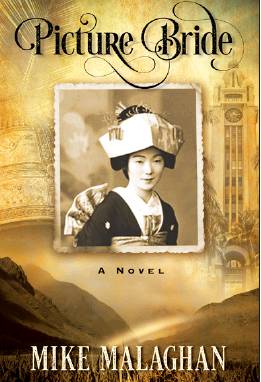ON THE SHELF
Picture Bride
by Mike Malaghan (Legacy Isle Publishing)
From the moment we meet Haru, we fall in love with this proud girl of silk and steel. To escape being sold into prostitution in turn-of-the-century Japan, Haru takes refuge in a Buddhist temple, but happiness there is fleeting. Betrayed by her best friend, she flees to Hawaii, a strange new world where the young picture bride finds herself with a husband who doesn’t want her and surrounded by a widespread distrust of Japanese immigrants.
As Haru’s marriage flourishes and then falters, she emerges as a strong-minded community leader. Have once pledged to produce sons to fight for the emperor, she dedicates herself to raising American children loyal to the Stars and Stripes.
From the shrines of Kyushu to the shores of the Territory of Hawaii, “Picture Bride” is the sweeping saga of Japanese immigrants who survived — and thrived — against great odds.
The lights flickered on at the Hawaii Theater’s premiere showing of the documentary “The First Battle,” revealing why most Japanese in Hawaii were not interned in World War II. A “eureka” moment. Only two weeks earlier, Mike Malaghan had decided to write a historical novel. While he spent a lifetime in the corporate world on four continents, in his heart he always thought of himself as a writer. Living in Hawaii, he already knew the story of the Nisei Territorial Guard, who were stripped of their uniforms weeks after Pearl Harbor only to enlist a year later when allowed. That was the stuff of a good story.
But these warriors did not just drop out of the sky on Dec. 7, 1941. They had mothers and fathers who had left an impoverished country to come to America. An immigrant story as rich as the Irish, the Italians, the Jews, etc., yet Malaghan could not find a single novel that told their story. “Picture Bride” is Volume 1 in a planned trilogy honoring the Japanese Americans who fought for America in World War II.
A lover and reader of history, Malaghan has been fortunate to visit 200 countries and territories starting in 1966 with the Peace Corps in Africa. Born in 1943 and later raised in Florida, he paid his way through the University of Florida by selling books doorto-door. After college he began a career in business, one that he concluded 41 years later as president of a Walt Disney licensee. In 2005, McGraw Hill published his legacy business book, “Making Millions in Direct Sales.”
As a consequence of his and his wife Tomoko’s passion for travel, they have ridden canoes in tribal Laos, “African Queen” river tugs down the Mekong and cruise ships meandering along the Danube, the Nile, the Amazon and the Yangtze rivers. They have climbed the mountains in Kinto Balu and the Japan Alps. Their live-on train experiences include South Africa, China, Tibet, India and the former Soviet republics in Central Asia. They also bungeejumped over the bridges of Taiwan, whitewater rafted on the Zambezi and hot-air ballooned over the game reserves of South Africa and Spanish ranches.
Much of the recent travels have centered on book research. The couple visited the island of Amakusa, where the major export for two generations were their daughters to the brothels of Asia. They walked through the cemetery in Sandakan, Borneo, where many of those unfortunates were buried in their teens and twenties. From this experience the picture bride Haru, who escapes this fate to become the mother of three Nisei soldiers, was born in Malaghan s imagination.
The couple later visited Hiroshima’s Fudoin Temple to better understand the Hiroshima of 1905. This temple is Haru’s home for four years. They rode mules up the mountain side in Kalaupapa, Molokai, to feel the life of lepers in 1912. They also toured the sugar cane plantation housing sites that were home to two generations of Japanese immigrants.
Still later they drove to Camp Shelby in Mississippi, where the 442nd trained for a year. In nearby Hattiesburg, they interviewed a Mississippi woman who married a Japanese American in 1942. They visited the Japanese American museums in Los Angeles and San Francisco and walked through their haunting re-creation of internment camp housing. They climbed the battlefields in Italy and France where the Nisei fought and died to take their place in the American pantheon of heroes.
No moment doing research for “Picture Bride” was more rewarding than lunch with Sue Isonaga, the 1939 au pair to FBI agent Robert Shivers. Her quiet Americanism created grave doubts about Shivers’ assigned role to prepare Japanese Americans for internment in Hawaii. Isonaga has since passed away. Malaghan trusts that Picture Bride” will help memorialize her contribution in preventing most Japanese in Hawaii from being incarcerated camps during the war.
“Definitive. It’s not often you can say that about any first novel. But ‘Picture Bride’ is destined to become the definitive story of the Japanese Americans’ experience, an epic multi-generation saga of a Japanese family meeting and defeating discrimination in Hawaii, a novel overflowing with drama, history and characters you’ll be rooting for the minute you open the book. Impeccably researched and skillfully told.” — William Martin, New York Times best-selling author of “The Lincoln Letter”
“Mike Malaghan expertly draws on historical events during the three decades leading up to WWII to portray Japanese immigrant life in Hawaii. ‘Picture Bride’ is an engaging family saga in an era that forged modern Hawaii — an era that must not be forgotten!” — Lenny Yajima, president, Japan-America Society of Hawaii

